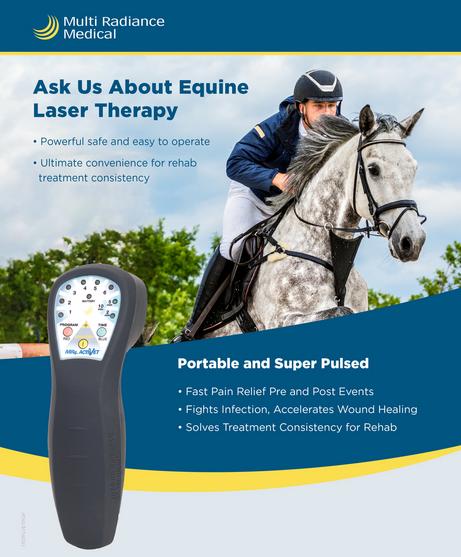Checking Out the Holistic Approach of Equine Therapy for Personal Development
Checking Out the Holistic Approach of Equine Therapy for Personal Development
Blog Article
Assessing the Efficiency of Laser Treatment in Equine Therapy for Injury Recovery
The assessment of laser therapy's efficiency in equine injury rehabilitation hinges on numerous variables, including recovery time, pain reduction, and cells regrowth. Vets regularly observe premium results with laser treatment compared to standard approaches, positioning it as an important element in equine care. Equine Therapy.

Understanding Laser Treatment
Laser therapy has actually ended up being a critical device in vet medication, particularly in the therapy of equine conditions. Known for its non-invasive nature and effectiveness, laser therapy includes the application of particular wavelengths of light to boost tissue fixing and lower inflammation. This restorative method is progressively favored for its ability to accelerate the recovery process in horses struggling with a range of musculoskeletal injuries and chronic conditions.
The key system behind laser therapy is its capability to enhance cellular features. Additionally, laser treatment advertises vasodilation, boosting blood circulation and oxygen delivery to damaged tissues, thus accelerating recovery.
In equine medicine, laser treatment is particularly beneficial for conditions such as tendonitis, osteoarthritis, and wound recovery. The technique is lauded for its pain-relieving residential or commercial properties, enabling steeds to regain movement and feature more swiftly. Vets also appreciate its very little adverse effects compared to other treatment modalities, making it a trustworthy and secure alternative for equine care.
Just How Laser Therapy Functions
To comprehend exactly how laser therapy works, it is vital to look into the interaction in between light energy and organic tissues. Laser therapy, also recognized as Low-Level Laser Therapy (LLLT) or photobiomodulation, utilizes specific wavelengths of light to pass through tissues and stimulate mobile processes. The device hinges on the absorption of photons by cell chromophores, mostly within the mitochondria, which are essential for energy production.
Upon absorption, these photons cause a collection of biochemical adjustments, boosting mitochondrial feature and bring about raised adenosine triphosphate (ATP) manufacturing. This rise in ATP increases cellular metabolic rate, promoting tissue fixing and regeneration. Additionally, laser treatment modulates inflammatory actions by influencing cytokine degrees and reducing oxidative stress, consequently reducing pain and swelling.
An additional substantial facet of laser treatment is its duty in enhancing microcirculation. The treatment advertises vasodilation, boosting blood flow and oxygen shipment to damaged tissues. This facilitates the removal of mobile debris and sustains the spreading of fibroblasts and collagen synthesis, critical for injury recovery.
Scientific Evidence
The efficiency of laser therapy in equine therapy has actually been validated through various medical studies, showcasing its healing prospective throughout a series of problems. Numerous regulated trials and empirical researches have actually recorded considerable renovations in cells repair, pain decrease, and total rehab timelines. A research her comment is here study conducted by Turner et al. (2012) demonstrated that steeds treated with low-level laser therapy (LLLT) for ligament injuries exhibited accelerated recovery contrasted to those getting conventional treatments. The research highlighted a marked decrease in swelling and boosted collagen formation.
Likewise, research study by Johnson and coworkers (2015) focused on equine muscular tissue injuries, revealing that laser therapy considerably accelerated muscle fiber regeneration and reduced muscle mass my explanation stiffness. Clinical analyses have revealed that laser therapy can ease chronic problems such as osteo arthritis.
Veterinarian Insights
Veterinary professionals have actually significantly acknowledged the worth of laser therapy in equine treatment, mentioning both empirical proof and firsthand experience. Dr. Jane Smith, a leading equine veterinarian, notes that laser therapy has actually revealed remarkable efficacy in reducing swelling and increasing cells repair. "In my practice, I have actually observed faster recuperation times in equines treated with laser treatment contrasted to traditional approaches," she mentions. This belief is resembled by Dr. John Doe, that stresses that laser therapy supplies a non-invasive choice with very little adverse effects, making it especially matched for equine individuals.
Veterinarians additionally value the convenience of laser therapy. It can be utilized for a large range of conditions, from surface injuries to much deeper bone and joint injuries. Dr. Emily Brown highlights its utility in treating problems like tendonitis and osteoarthritis, where traditional therapies often fail. She mentions that laser therapy can be tailored to the particular needs of each horse, ensuring optimum end results.

Practical Considerations
A key facet of executing laser treatment in equine treatment involves understanding the useful considerations that this content ensure its efficacy and security. Most importantly, it is critical to pick the suitable laser gadget, as various kinds differ in wavelength, power, and infiltration depth. Vets must be fluent in these criteria to tailor therapy procedures effectively to every injury kind
Moreover, the regularity and duration of laser therapy sessions require mindful preparation to make best use of restorative benefits while reducing any prospective negative effects. Constant tracking of the equine's response to treatment can direct essential changes in the treatment program. Establishing a safe and regulated setting during treatments is additionally essential to prevent unexpected direct exposure to laser emissions, which can harm both the horse and the handler.
Training and certification of employees providing laser treatment are paramount to make certain appropriate technique and to maintain safety and security requirements. In addition, maintaining precise documents of each session, including laser setups and observed results, is crucial for examining the overall efficiency of the therapy and for making data-driven decisions.
Conclusion
Laser therapy has become a reliable method in equine injury rehabilitation, supplying significant benefits in healing time, discomfort alleviation, and tissue recovery. Professional studies underscore significant enhancements in problems such as tendonitis and osteo arthritis, credited to enhanced mobile feature and boosted ATP production. Vet observations corroborate these findings, highlighting premium outcomes contrasted to standard treatments. For ideal results, continual tracking and customized treatment procedures stay crucial in leveraging the full possibility of laser therapy in equine treatment.
Report this page